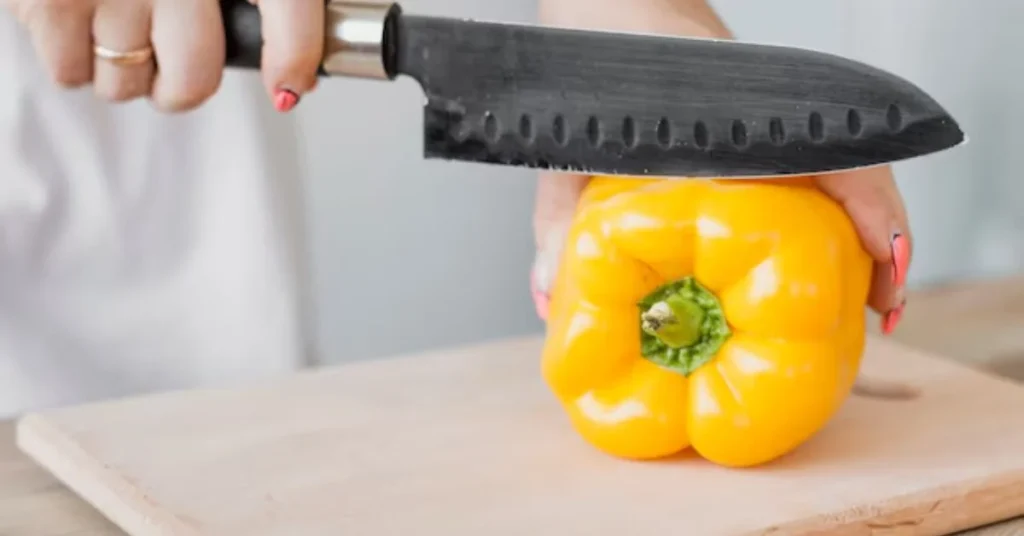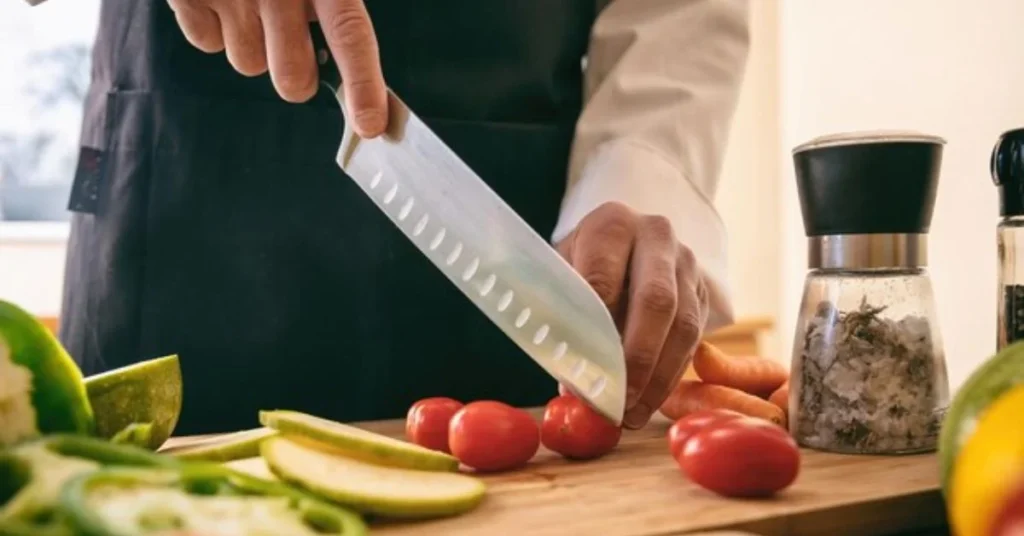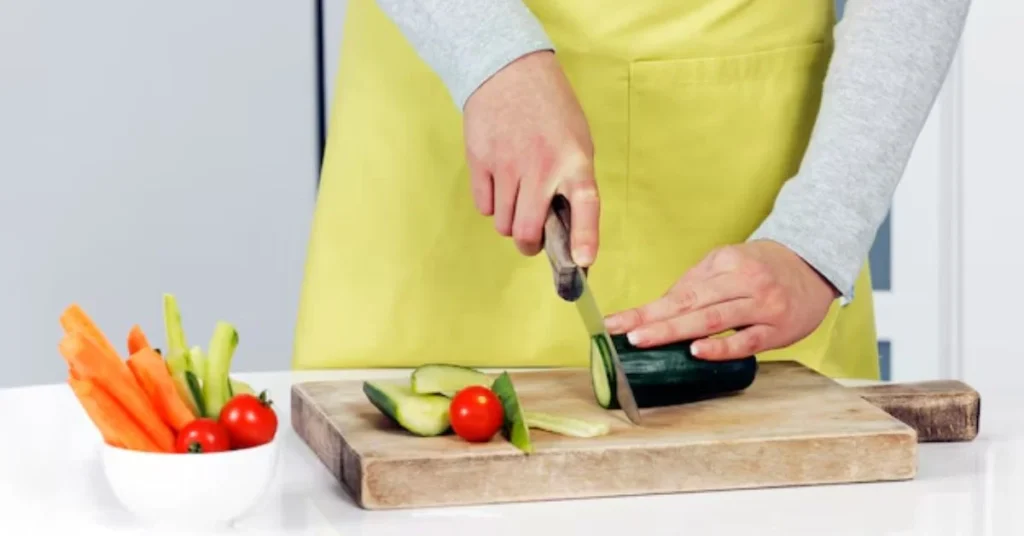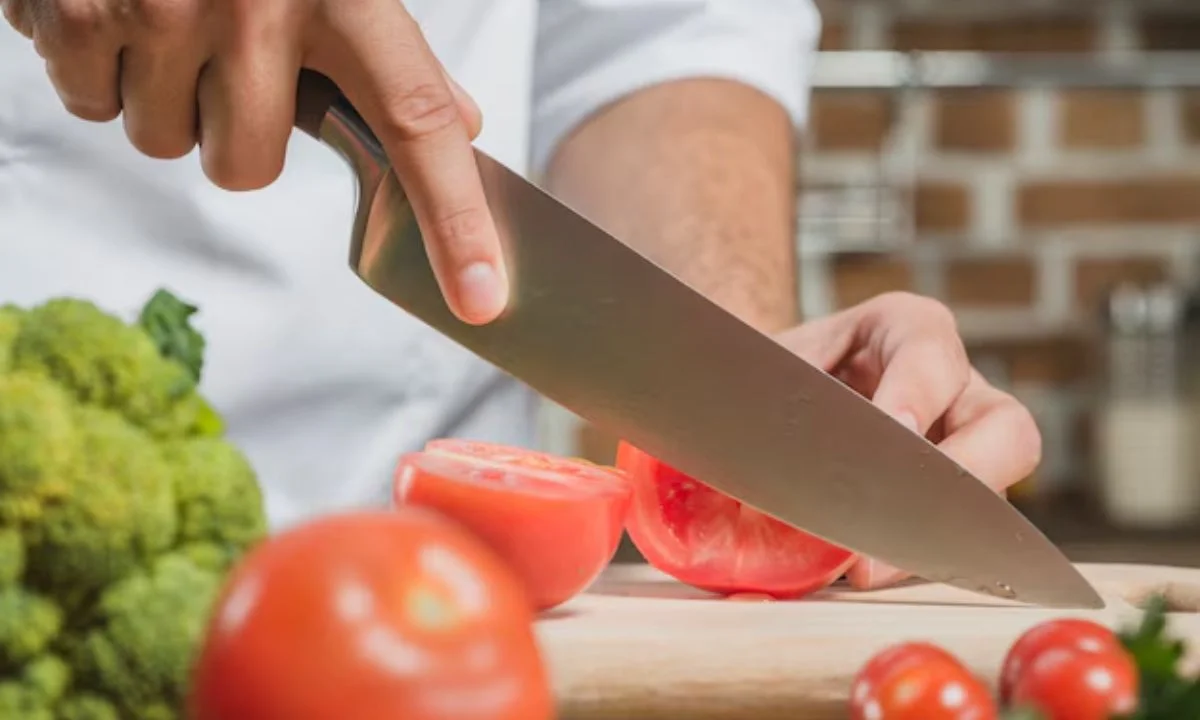When it comes to kitchen knives, the angle of the blade edge matters for cutting performance and ease of use. So, what degree is the average kitchen knife? Most kitchen knives have a blade angle between 15 and 20 degrees per side, depending on their style and purpose. In this guide, we’ll explore why this angle is important, how it varies among different knife types, and what you need to know to keep your knives sharp.
Understanding Kitchen Knife Blade Angles
The angle of a kitchen knife blade is the degree to which the edge is sharpened. This angle determines the sharpness and durability of the knife. Generally, a lower angle (between 10-15 degrees) means a sharper, more delicate edge, while a higher angle (20-30 degrees) provides a durable but slightly less sharp blade.
Must read Mass Factory Cooking Kitchen: An Inside Look at Large-Scale Food Production
Why Blade Angle Matters
Blade angle affects both performance and maintenance. A lower angle cuts more precisely, making it ideal for slicing vegetables or filleting fish. However, it may require more frequent sharpening. Higher angles are more robust and are well-suited for chopping tough foods, like meat or root vegetables.
Average Angle for Common Kitchen Knives
For most general kitchen knives, an angle between 15 and 20 degrees per side is typical. Western-style knives usually feature a 20-degree angle, while Japanese-style knives, known for their precision, often have a 15-degree angle.
Different Knife Types and Their Blade Angles
Chef’s Knives
Chef’s knives are versatile and used for various tasks like slicing, dicing, and chopping. The average blade angle for a chef’s knife is around 15-20 degrees per side, balancing sharpness and durability.
Paring Knives
Paring knives, often used for small, delicate tasks like peeling and trimming, generally have a 15-degree blade angle. This sharper edge allows for precision in detailed work.
Santoku Knives
Santoku knives, popular in Japanese cooking, usually have a 12-15 degree blade angle. This low angle makes them incredibly sharp and ideal for slicing vegetables, fish, and lean meats with minimal force.
Bread Knives
Bread knives feature serrated edges, typically with an angle of about 20-25 degrees. This angle, combined with serrations, helps the blade cut through crusty bread without crushing the soft inside.

How to Determine the Angle of Your Kitchen Knife
Understanding the angle of your knife can help you maintain its sharpness effectively. You can often find this information from the manufacturer, or you can measure it with an angle guide or sharpening tool.
Using an Angle Guide
Angle guides are useful for measuring and setting the correct angle when sharpening a knife. They are often used with sharpening stones or tools to ensure consistent results.
Checking Manufacturer Information
Most knife manufacturers provide details on the blade angle, especially for high-quality knives. Knowing this can help you follow proper sharpening techniques and prolong the life of your knife.
How to Sharpen Your Kitchen Knife to the Right Angle
Using a Sharpening Stone
Sharpening stones are a popular choice for maintaining knives. Place the knife at the desired angle and run it along the stone in smooth, controlled strokes. For example, hold a Japanese knife at 15 degrees or a Western knife at 20 degrees.
Honing Rods and Electric Sharpeners
Honing rods are often used to maintain the blade between sharpenings, while electric sharpeners can help you achieve a specific angle, such as 15 or 20 degrees, easily.
Professional Sharpening Services
If you’re unsure about sharpening your knife yourself, consider professional services. Experts can help maintain the original blade angle, ensuring your knife performs well over time.
Why Japanese Knives Have Sharper Angles
Japanese knives are famous for their sharpness, often having blade angles of 12-15 degrees per side. This lower angle creates a finer, sharper edge, ideal for precision tasks in the kitchen. These knives are commonly made from harder steel, allowing them to maintain a sharper angle without dulling quickly. However, they may require extra care and maintenance.
Benefits of Sharper Angles in Japanese Knives
Japanese knives can slice through foods more easily due to their sharper edges, which is beneficial for delicate cuts. The lower angle makes them perfect for slicing sushi, vegetables, and thin meats with minimal resistance.

Drawbacks of Sharper Angles
While sharper angles allow for better-cutting precision, they can be more prone to chipping or dulling if not handled properly. Japanese knives with sharper angles may need to be sharpened more frequently to maintain their performance.
What degree is the average kitchen knife?
Western knives, such as those from European brands, typically have a 20-degree blade angle per side. This higher angle gives the blade a more durable edge, allowing it to withstand tougher ingredients and heavy use. Western knives are versatile and ideal for handling a wide range of kitchen tasks.
Advantages of a Higher Blade Angle
The 20-degree angle is more resistant to wear and can handle hard foods like meat and bones without dulling quickly. Western knives also require less frequent sharpening, making them low-maintenance for everyday use.
Disadvantages of Higher Angles
The higher angle makes Western knives slightly less sharp compared to Japanese knives. While this may not matter for general use, it might not be ideal for tasks that require extreme precision, such as slicing sushi or filleting fish.
Choosing the Right Blade Angle for Your Cooking Needs
High-Precision Tasks
If you need a knife for detailed tasks, a blade angle of 15 degrees or lower is recommended. Japanese knives or specially sharpened chef’s knives can achieve these angles, offering excellent control and precision.
General Kitchen Use
For most home kitchens, a 20-degree blade angle is more practical. Western-style chef’s knives with this angle are durable and versatile, making them suitable for chopping, slicing, and dicing various ingredients.
Specialized Tasks
For bread, a serrated knife with an angle of around 20-25 degrees is ideal. This type of knife requires less frequent sharpening due to its serrated design and higher angle.
Maintaining the Blade Angle of Your Kitchen Knife
Regular Honing
Honing a knife regularly keeps the blade aligned, helping it stay sharp longer. It’s recommended to hone your knife at the same angle as its blade edge to prevent dulling.
Proper Storage
Proper knife storage helps preserve the blade angle and protects the edge from damage. Knife blocks, magnetic strips, or knife guards can prevent chips and dulling.
Avoiding Hard Surfaces
To maintain a knife’s blade angle, avoid cutting on hard surfaces like glass or stone. Instead, use cutting boards made from wood or plastic, which are gentler on the knife’s edge.

Conclusion: What Degree is the Average Kitchen Knife
In conclusion, understanding what degree is the average kitchen knife can improve your kitchen experience by helping you choose the right knife for your needs. Most kitchen knives have a blade angle between 15 and 20 degrees, balancing sharpness and durability for versatile use. Japanese knives, with sharper angles, excel in precision tasks, while Western knives, with higher angles, are durable for general use. By knowing your knife’s angle, you can maintain its sharpness and performance, making food preparation easier and more enjoyable. Click here for more information.
What degree is the average kitchen knife angle?
The average kitchen knife has a blade angle of 15-20 degrees per side, depending on the type and purpose of the knife.
Why do Japanese knives have sharper angles?
Japanese knives typically have a sharper angle of 12-15 degrees, which allows for more precise cuts but may require more frequent sharpening.
How can I measure my kitchen knife’s blade angle?
You can use an angle guide or check with the manufacturer to find out the blade angle. Some sharpening tools also have angle settings for accuracy.
What angle should I use to sharpen a chef’s knife?
A typical chef’s knife should be sharpened to 15-20 degrees per side. Japanese chef knives are often sharpened to 15 degrees, while Western knives may use 20 degrees.
How can I keep my kitchen knife sharp?
Regular honing, proper storage, and avoiding hard-cutting surfaces help maintain a knife’s sharpness. Using a sharpening stone or professional services also preserves the blade angle.
